Those suspicious-looking vines growing up your tree can kill the tree and give you a painful rash if you touch them. For the safety and well-being of you and your loved ones, poison ivy should be removed from your trees.
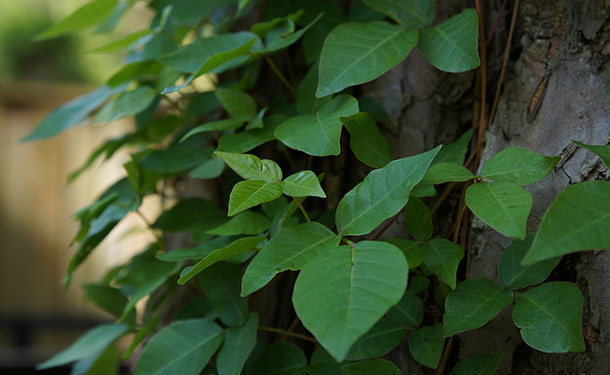
thetreecareguide.com gathered information about poison ivy, how to identify it, how to remove it from trees, how the rash is spread, and how to treat the rash.
Poison Ivy on Trees
You may think of poison ivy as a creeping vine along the ground or growing over small bushes and structures. While this is true, there is another side to poison ivy that you may have never noticed.
Whether in the countryside or the city, poison ivy can latch onto trees and upright structures. If allowed to grow long enough, poison ivy can weave its way throughout the entire canopy of a tree. It can take on the appearance of a tree with “limbs” sprouting out from its host by as much as 6 to 8 feet.
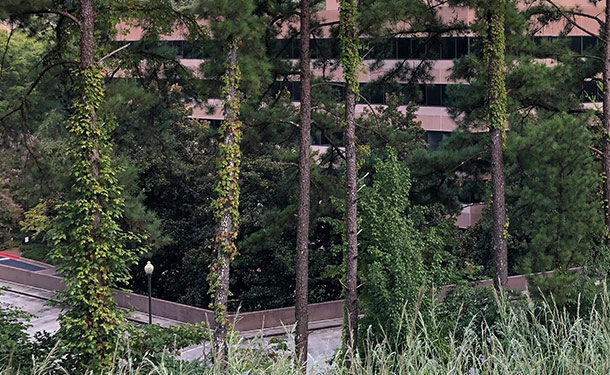
With the ability to grow as ground cover, shrubs or climbing vines, poison ivy is found throughout North America (except in the desert, Alaska, and Hawaii) growing in open fields, wooded areas, on trees, and along roadsides or riverbanks.
Learn more about how climbing vines can kill trees by reading thetreecareguide.com/climbing-vines-tree-killers
How to Identify Poison Ivy on Trees
Positively identifying poison ivy can be a little tricky. The following traits can help you avoid contact with this “irritating” species:
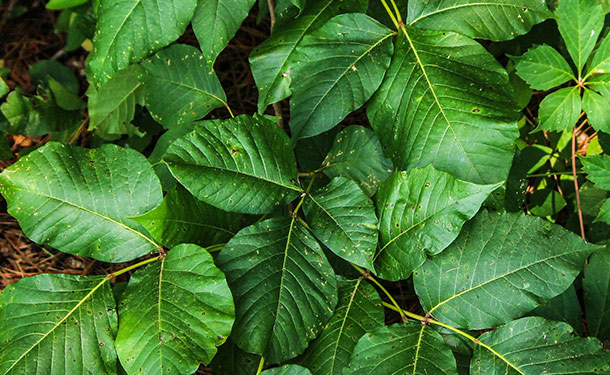
• Poison ivy grows with a large leaf at the end of a stem and a slightly smaller leaf shooting off on either side (leaves of three).
• The leaves have pointed tips and can have notched or smooth edges.
• Foliage is reddish in the spring, green in summer, and yellow or orange in the fall.
• Clusters of green and white berries and green or yellow flowers are common through spring and summer.
• As a climbing vine, poison ivy roots attach to a tree, fence post, or light pole using rootlets (see image below), and is the more reliable indicator of this species.
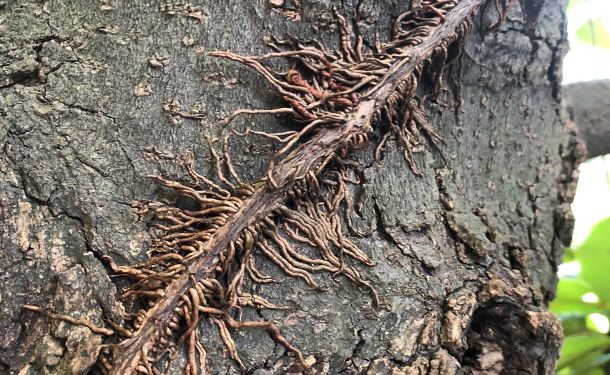
The adage “leaves of three, let them be” is real. While there are other plant species with this trait, it is best to avoid these plants, unless you are sure the plant is not poison ivy and poses no threat.
How to Safely Remove Poison Ivy from Your Tree
There are two principal ways to remove poison ivy from your trees:
Herbicidal Treatment – Use glyphosate or herbicide with the compound Triclopyr. Always follow the directions on the label precisely.
You can use pruning shears or a hatchet to nick the trunk in several locations (deep enough to expose the xylem and phloem), then apply the herbicide to the open wounds. By spring the plant will have taken up the chemical and should not leaf out.
Or you can sever the vine close to the ground and immediately apply or daub the open wound with the herbicide using a paintbrush for directed spot-treatment or equipment as suggested by the product label.
Physical Removal – If your plan includes removing freshly cut or long-dead poison ivy, the following will help you avoid contact with the rash-causing urushiol (u-ROO-she-ol) oil.
• Apply a barrier cream to any exposed skin before handling poison ivy (over-the-counter creams are recommended)
• Protect your hands with washable or thick disposable gloves
• Wear long sleeves and long pants
• Wear tube socks (knee-high if possible) and boots
• Do not touch or scratch any exposed skin after contact with poison ivy
• Do not burn poison ivy cuttings. Smoke may carry the oil, allowing you to breathe in the irritant.
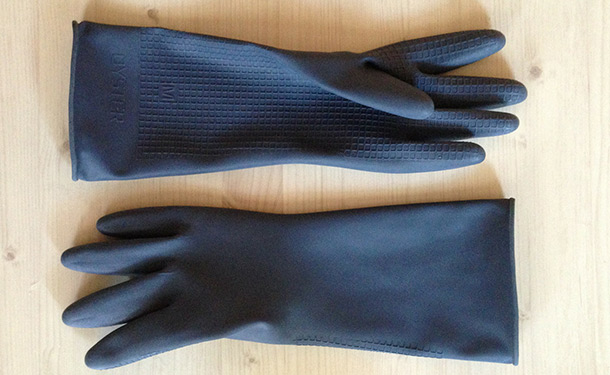
When removing poison ivy, it is essential to remember that the urushiol oil is present in the foliage, the stems, and in the roots. Use extreme caution when pulling up the roots of poison ivy.
For roots that have attached or clung onto the trunk of your tree, take extra care to prevent the removal of the tree bark. In cases of mature poison ivy growth, it may not be possible to remove the attached roots without severely damaging the host tree.
In the winter (when the plant is dormant), or when the plant has been dead for several months, the danger associated with urushiol oil continues. This oil may persist for years on dead foliage or plant parts.
After removing poison ivy from your tree, the following will help you avoid contact with urushiol oil:
• Carefully remove the gloves and wash them in hot, soapy water (detergents work well) or dispose of them
• Wash your hands thoroughly
• Carefully remove your clothing, placing it directly in a washing machine (wash with hot water and laundry detergent)
• Use caution when removing your clothing to avoid transferring the urushiol oil to yourself, furniture, carpeting, walls, or appliances
• Thoroughly wash your shoes and shoelaces with hot soapy water
• Take a shower, thoroughly washing your face, neck, arms, hands, and other body parts that may have been exposed to the plant
• Using disposable gloves, wash all equipment used to remove the plant with hot soapy water
If you suspect or are exposed to urushiol oil, you have between 15 and 30 minutes before the oil penetrates and bonds with the deeper layers of your skin.
What to Do After Exposure to Poison Ivy and Urushiol Oil
The development of a poison ivy rash occurs as an allergic reaction to urushiol oil. This oil naturally occurs in the leaves, stems, and roots of poison ivy.
Avoid Spreading the Oil – The rash may be spread by touching the plant, contaminated clothing, surfaces, or body part, then touching another body part.
Pets may carry the oil on their fur after playing in areas where the plant is growing and spread that oil to anyone who subsequently makes contact with the contaminated fur.
If you suspect that your pet has contacted poison ivy, put on some plastic gloves, protective clothing, and give it a thorough bathing.
Wash It Off – If you know you have come in contact with poison ivy, use hot, soapy water to thoroughly cleanse your skin.
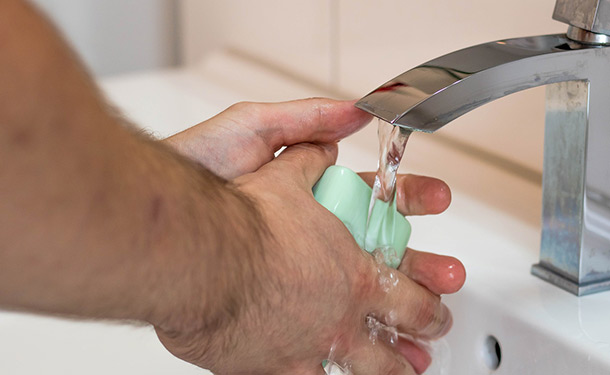
When a rash develops, it will be sensitive and should still be washed with hot, soapy water. This will minimize the potency of the oil and avoid spreading it to other body parts.
Don’t Scratch – A rash caused by urushiol oil is typically sensitive, itchy, and can persist for weeks. Avoid scratching affected areas to prevent bacteria from your fingernails, causing an infection.
Treatment – In mild cases of poison ivy rash, cool baths, soothing lotions, or over-the-counter medicated lotions can be used to minimize the symptoms while the skin heals.
More severe rashes (with blistering or oozing pus) or rashes on the face and genitals should be examined and treated by your primary care physician. In these cases, prescription medication, including antibiotics, may be necessary to treat the symptoms.
Prevention – To prevent a poison ivy rash, follow these tips:
• Learn how to identify poison ivy in all seasons
• Avoid touching or grabbing unfamiliar foliage
• Avoid any skin contact with poison ivy
• Remove poison ivy from your landscape
• When hiking, try to stay on cleared pathways
• When camping, pitch tents in areas free of poison ivy
• Keep pets from playing in wooded areas to keep urushiol oil from sticking to their fur
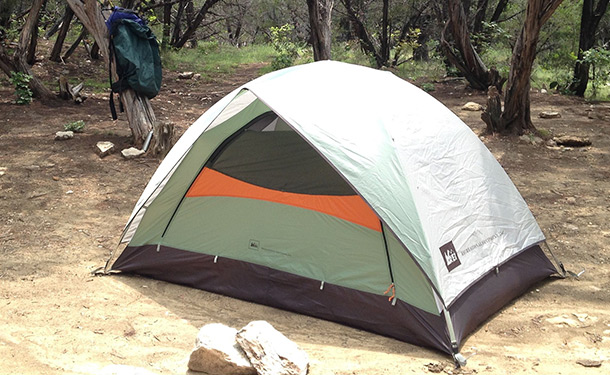
NOTE: Urushiol oil can remain potent for several years. If you put away a contaminated piece of clothing without washing it and take it out one year later, the oil on the clothing may still cause a rash.
My Trees and Poison Ivy Vines
The vines on your tree may pose a health risk to you and your loved ones while it robs your tree of essential sunlight and nutrients.
In this article, you discovered how to identify poison ivy, safely remove it from your trees, avoid spreading the rash, and treatment for a rash once you have it.
Allowing poison ivy to grow on your trees and in your landscape can kill your trees and result in violent rashes caused by the urushiol oil that’s produced by the plant.
Sources:
canr.msu.edu/news/poison_ivy_when_is_a_tree_not_a_tree
mayoclinic.org/diseases-conditions/poison-ivy/symptoms-causes/syc-20376485
medlineplus.gov/poisonivyoakandsumac.html